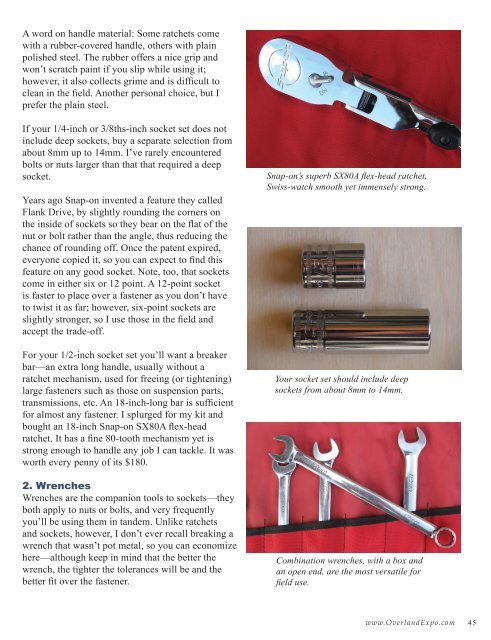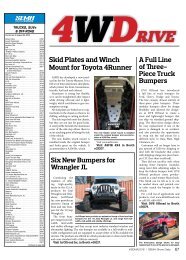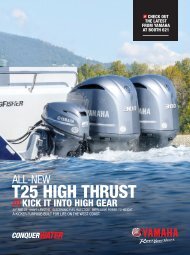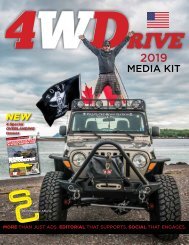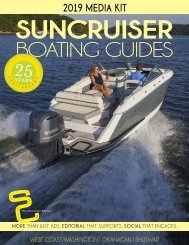Overland Sourcebook 2018 EAST
You also want an ePaper? Increase the reach of your titles
YUMPU automatically turns print PDFs into web optimized ePapers that Google loves.
A word on handle material: Some ratchets come<br />
with a rubber-covered handle, others with plain<br />
polished steel. The rubber offers a nice grip and<br />
won’t scratch paint if you slip while using it;<br />
however, it also collects grime and is difficult to<br />
clean in the field. Another personal choice, but I<br />
prefer the plain steel.<br />
If your 1/4-inch or 3/8ths-inch socket set does not<br />
include deep sockets, buy a separate selection from<br />
about 8mm up to 14mm. I’ve rarely encountered<br />
bolts or nuts larger than that that required a deep<br />
socket.<br />
Years ago Snap-on invented a feature they called<br />
Flank Drive, by slightly rounding the corners on<br />
the inside of sockets so they bear on the flat of the<br />
nut or bolt rather than the angle, thus reducing the<br />
chance of rounding off. Once the patent expired,<br />
everyone copied it, so you can expect to find this<br />
feature on any good socket. Note, too, that sockets<br />
come in either six or 12 point. A 12-point socket<br />
is faster to place over a fastener as you don’t have<br />
to twist it as far; however, six-point sockets are<br />
slightly stronger, so I use those in the field and<br />
accept the trade-off.<br />
For your 1/2-inch socket set you’ll want a breaker<br />
bar—an extra long handle, usually without a<br />
ratchet mechanism, used for freeing (or tightening)<br />
large fasteners such as those on suspension parts,<br />
transmissions, etc. An 18-inch-long bar is sufficient<br />
for almost any fastener. I splurged for my kit and<br />
bought an 18-inch Snap-on SX80A flex-head<br />
ratchet. It has a fine 80-tooth mechanism yet is<br />
strong enough to handle any job I can tackle. It was<br />
worth every penny of its $180.<br />
2. Wrenches<br />
Wrenches are the companion tools to sockets—they<br />
both apply to nuts or bolts, and very frequently<br />
you’ll be using them in tandem. Unlike ratchets<br />
and sockets, however, I don’t ever recall breaking a<br />
wrench that wasn’t pot metal, so you can economize<br />
here—although keep in mind that the better the<br />
wrench, the tighter the tolerances will be and the<br />
better fit over the fastener.<br />
Snap-on’s superb SX80A flex-head ratchet,<br />
Swiss-watch smooth yet immensely strong.<br />
Your socket set should include deep<br />
sockets from about 8mm to 14mm.<br />
Combination wrenches, with a box and<br />
an open end, are the most versatile for<br />
field use.<br />
www.<strong>Overland</strong>Expo.com<br />
45<br />
<strong>2018</strong>_<strong>Sourcebook</strong>_Azlitho_<strong>EAST</strong>.indd 45<br />
10/2/18 9:34 AM


